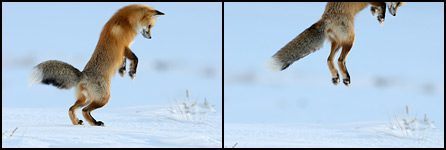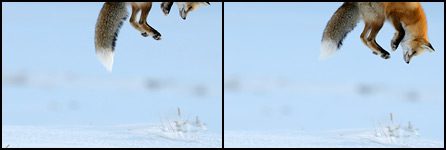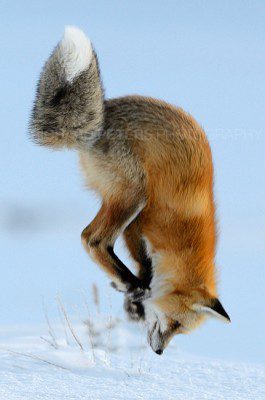It happens to the best of us. When you’re photographing wildlife, you never know what to expect and when. And I had a very good lesson in trying to remember to keep on top of my camera settings and not just shoot away, relying on the camera to do it all for me. Something that can be easy to do in the heat of the moment. I just wish this reminder hadn’t come when I was out in Yellowstone photographing a Red Fox mousing.
[UPDATE, August 2012: Since writing this article, almost two years later one of the images from the sequence, has won a Commended Award in the highly prestigious Wildlife Photographer of the Year competition, which you can read about here.]
Lesson to learn: Always try to keep an eye on your camera settings. On this occasion, as I was shooting with two bodies and three lenses, switching between telephotos, mid-range zoom and wide angle. As a result my settings got lost in my head. What I should have done, was reset the camera to my favourite default settings after using each type of lens, giving me slightly more chance to set the camera quickly for the next scenario.
What went wrong on this occasion, is we had been photographing this Red Fox out in the distance, which was mousing (they listen for mice under the snow, then jump in the air and dive down under the snow to catch them). I had my camera set in Auto ISO, and was getting shutter speeds up in the 1/2000+ region as it was so bright from the snow. After a while the fox vanished behind a snow bank, and when it reappeared, it was right up along the road side and next to our car. To make it even better, the snow bank was a good 4 foot high, placing the fox at our eye level. I knew I didn’t have time to jump out and setup the tripod, so I had to just point the camera out the window and fire away.

Red Fox begins to pounce
I could see the fox was tilting it’s head at the ground, indicating a pounce was potentially about to happen. It was the perfect size in the frame for a portrait, but I knew for a pounce it was way too close, but as I was shooting the 600mm on the D7000 had to just hope for the best. As the fox pounced, it jumped almost clear out of the frame, these things can jump high!

Red Fox almost clears the frame
It landed head first and buried itself in the snow with just the rear legs sticking out, before pulling itself out and and running off across the road and up the hill to our left. The moment was gone, so I nervously checked back through my images. Just one shot had caught the perfect mid air dive. It wasn’t perfectly framed but a crop to portrait could save that. I excitedly zoomed in to check the sharpness…and that’s when it hit me. It was soft. Very very soft, even with aggressive sharpening. I checked the exif and discovered why, it was only at 1/500s, not fast enough to freeze the downwards dive. It was then that I realised that was the lower limit I had set Auto ISO to earlier on for another shot I had been taking previously. And because when the fox jumped, the camera was pointing across to a huge shaded area in the background, it forced the shutter speed down, so those 1/2000s+ speeds were long gone.

Almost the perfect Red Fox pounce shot!
EDIT 2012: And to think after being hung up on the shot about not coming out how I would have liked, it ended up being another image from the sequence that I had initially over looked, that became the true star!
It’s one of those things unfortunately. Sometimes you just get caught well and truly off guard, and when it happens, it happens! Had the shot been sharp I would have been thrilled, but what can you do (other than cry of course, lol). So remember, always keep an eye on your settings and give yourself as much chance as possible to nail the perfect shot next time the opportunity arises.
Oh and for those of you wondering, the fox didn’t catch the mouse either, so neither of us made the best of the situation…
You can read more blog posts about my Yellowstone Winter Wildlife trip, here.








